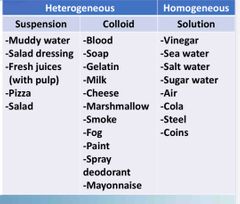![]()
![]()
![]()
Use LEFT and RIGHT arrow keys to navigate between flashcards;
Use UP and DOWN arrow keys to flip the card;
H to show hint;
A reads text to speech;
15 Cards in this Set
- Front
- Back
|
What is a physical change |
DescriptionPhysical changes are changes affecting the form of a chemical substance, but not its chemical composition. |
|
|
What is chemical change |
DescriptionChemical changes occur when a substance combines with another to form a new substance, called chemical synthesis or, alternatively, chemical decomposition into two or more different substances. |
|
|
What the difference between chemical and physical change |
a chemical change produces a new substance, while a physical change does not. A material may change shapes or forms while undergoing a physical change, but no chemical reactions occur and no new compounds are produced. |
|
|
what is a homogeneous mixture |
A homogeneous mixture is a solid, liquid, or gaseous mixture that has the same proportions of its components throughout any given sample. ... An example of a homogeneous mixture is air. In physical chemistry and materials science this refers to substances and mixtures which are in a single phase. |
|
|
what is a heterogeneous mixture |
A homogeneous mixture is a solid, liquid, or gaseous mixture that has the same proportions of its components throughout any given sample. Conversely, a heterogeneous mixture has components in which proportions vary throughout the sample. |
|
|
What is a mixture |
A mixture is a substance made by combining two or more different materials in such a way that no chemical reaction occurs. A mixture can usually be separated back into its original components. Some examples of mixtures are a tossed salad, salt water and a mixed bag of M&M's candy. |
|
|
What is a substance |
A chemical substance is a form of matter having constant chemical composition and characteristic properties. Some references add that chemical substance cannot be separated into its constituent elements by physical separation methods, i.e., without breaking chemical bonds |
|
|
what's the difference between mixture and pure substance |
1. Pure substances cannot be separated into any other kinds of matter, while a mixture is a combination of two or more pure substances. 2. A pure substance has constant physical and chemical properties, while mixtures have varying physical and chemical properties (i.e., boiling point and melting point) |
|
|
What is a compound |
A compound is a substance formed when two or more chemical elements are chemically bonded together. In mixtures, the substances present are not chemically bonded together. The type of bonds holding elements together in a compound can vary: two common types are covalent bonds and ionic bonds. |
|
|
What is a element |
DescriptionA chemical element is a species of atom having the same number of protons in their atomic nuclei. For example, the atomic number of oxygen is 8, so the element oxygen consists of all atoms which have 8 protons |
|
|
Rules of element |
One type of atom Simplest form of matter Can't be broken down into smaller pieces The symbol of all element are found in the periodic table |
|
|
Were is the atomic number and atomic mass number |

Back (Definition) |
|
|
What is an element group and period |
Groups and periods are two ways of categorizing elements in the periodic table. Periods are horizontal rows (across) the periodic table, while groups are vertical columns (down) the table. Atomic number increases as you move down a group or across a period. |
|
|
difference between colloid suspension and solution |
A solution is always transparent, light passes through with no scattering from solute particles which are molecule in size. ... A colloid is intermediate between a solution and a suspension. While a suspension will separate out a colloid will not. Colloids can be distinguished from solutions using the Tyndall effect |
|
|
Examples of colloid suspension and solution |

Back (Definition) |

